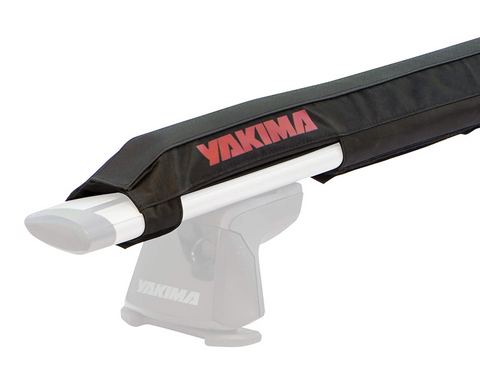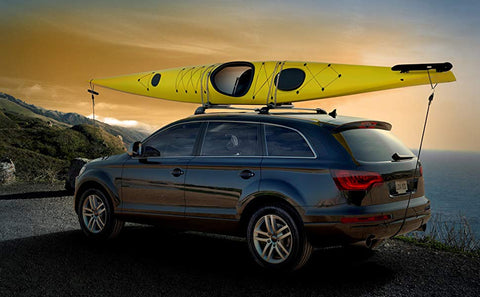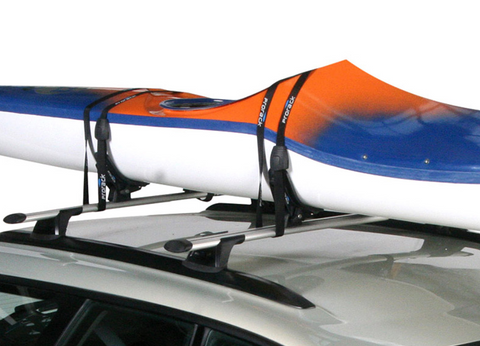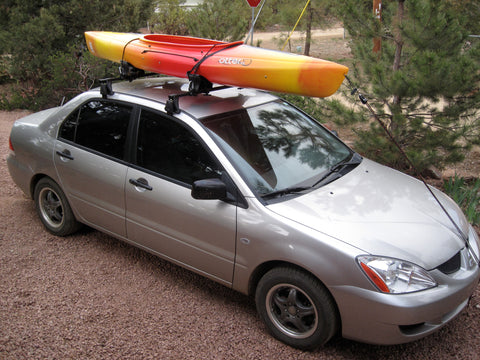How to Transport a Kayak
Aug 05, 2019
Kayaking is a great way to get outdoors and connect with nature. A kayak can open up a whole world of unexplored waterways. The issue for many, however, is getting the boat to the adventure! Transporting your kayak safely and efficiently is a crucial skill any first-time or experienced paddler should have in their arsenal, but starting can seem a little daunting.
Kayaks come in a vast range of shapes and sizes, with even the most modest boats measuring over 2m in length. There are several factors to consider from what gear you’re going to need to how you’re going to prepare your vehicle and boat for transportation. So where do you begin?

To help get you started, we have put together an essential guide for safely transporting a kayak.
Preparing your vehicle
Before you load your kayak, be sure to have the following items ready:
Roof racksRoof racks are a necessary part of safely transporting your kayak. A sound racking system will protect both your car and boat from unwanted dings and scratches. There are a couple of different options depending on what type of vehicle you have. Take a look at the roof of your car and use our handy guide to determine your roof type:
-
Bare Roof
A Bare Roof is entirely void of any attachment points. If you have a Bare Roof vehicle, do not despair! There are still roof rack options for you to transport your kayak without damaging your car. Read on below for our top picks for this roof type. -
Side Rails
Side rails come in two forms - Raised or Flush. With Raised Side Rails, you should have two rails running parallel to the doors. There will be a gap between the rails and the roof of the vehicle roughly large enough to slide your hand through. Unlike their raised counterparts, Flush Side Rails do not have a space between the rails and the roof. Both types of side rails offer strong attachment points designed to support a Hard Rack system. -
Gutters
Less common on modern vehicles, Gutters are ridges that run along the top of the doors on either side of the car. This ridge protrudes slightly from the side of the vehicle providing an anchor point for roof racks. -
Fixed Points
Fixed Points are four hidden attachment points. These are usually covered by a plastic cap that you can open to access the points. A roof rack system can then be bolted into these points providing a neat finish with a very sturdy load limit. -
Tracks
Tracks are long channels, slots or tracks that run parallel to the door on the outer edge of your roof. Tracks are either factory-installed or added to a vehicle after purchase. If you have tracks on your roof, you will be able to remove the plastic cover and purchase a rack that slots into your specific vehicle. -
Factory Crossbars
Factory Crossbars are pre-installed between Side Rails of a vehicle by the dealership. If you have Factory Installed Crossbars, you may think you have your roof rack solution all neatly tied up, but there are still a few more things you need to check off your prep list before hitting the road.
Once you know your roof type, you can begin to choose your roof rack solution:
-
Soft Racks
If you have a four-door vehicle with a Bare Roof, Fixed Points or Tracks, Soft Racks are a great solution. Soft Racks can be foam or inflatable and are the simplest solution to safe kayak transportation. They are essentially two tubes with straps running through them. The straps are passed through the front and rear doors to secure the racks in place. Soft racks are easy to install and remove and are compact for convenient storage.

-
Hard Racks/Mounted Crossbars
Hard Racks (otherwise known as Mounted Crossbars) are commonly designed for cars with Side Rails, Gutters, Tracks or Fixed Points. Unlike Soft Racks, Hard Racks are not universal. Brands will have a vast range of racks to fit your cars specification. If you are not sure whether a Hard-Rack solution is right for you, jump on our chat function and speak to a local member of staff.

-
Pads
If you have Factory Mounted Crossbars or have chosen a Hard Rack solution, you may want to add an extra layer of protection to stop your boat getting damaged by coming into contact with the rigid racks. Foam padding will do this. Good quality foam pads such as the Yakima Aero Crossbar Pads are made from an anti-slip material which will also help keep your gear in place.

Crossbar pads fitted to car roof racks protect your kayak and the racks.
Tie-down straps
So you have the roof racks down - what’s next? Well, you don’t want to drive off without securing your kayak! For that, you will need some sturdy tie-down straps. You want to look for purpose-made pull-down or ratchet straps. These are designed to easily create high tension to hold your gear firmly in place. Most straps will come as a pair so you can secure the kayak at two points; this will distribute the load safely along the length of your vehicle. Look out for straps with a silicon or padded buckle cover as this will stop any damage to your car when you throw the straps over the kayak to the other side.
A couple of lengths of rope will be sufficient as bow and stern lines. These lines are not to secure your kayak tightly like with the tie-downs, but rather to stop your kayak from slipping forwards or backwards when braking or accelerating harshly.
 Tie down points are great for keeping your kayak rocking forward and backward.
Tie down points are great for keeping your kayak rocking forward and backward.
Rack Accessories
If you are travelling a long distance with your kayak, you may want to consider a specifically engineered kayak holder or mounted rack accessory. A ProRack Canoe/Kayak Holder Kit will add extra support for your kayak. They are designed to keep your kayak from moving when travelling at speed and can be fitted directly into Tracks or mounted on Hard-Racks or Crossbars.

ProRack Kayak Cradles on roof racks keep your kayak snug and secure.
J-Cradles are another great option. J-Cradles allow kayaks to be secured on their side, which is ideal for plastic boats where the sides are much stronger than the bottom. A J-Cradle will protect your boat from warping if it is secured on the roof for long periods. Folding J-Cradles do exactly that - they fold down when not in use, for better aerodynamics when you're driving. A universal, folding cradle is an excellent investment as it can be adapted to suit a number of boats meaning that as your kayak obsession grows, you can count on one accessory to suit your collection!
 Folding J-cradle mounts allow you to carry multiple kayaks on one vehicle
Folding J-cradle mounts allow you to carry multiple kayaks on one vehicle
Loading your kayak with assistance
Now that you have all your equipment prepared, it is time to load your boat. A two-person lift from ground to roof is the ideal option. Place the kayak alongside your vehicle with the bow at the front and the stern towards the back. If you are loading your kayak directly onto a racking system, be it hard or soft racks, the kayak should be up-side-down. If you are loading onto a kayak holder or cradle you want it right-side-up as the hull will slot into the cradle.
With one person at the stern and the other at the bow bend with your knees and lift the kayak together onto the rack.
Loading your kayak solo
Loading a kayak by yourself can be a challenge; this is where a kayak loading accessory will make all the difference. There are lots of load assist products out there, but they can often be expensive, complicated and tailored to one rack system - not ideal. A great solution is the K-Rack Kayak Load Assist. Each K-Rack has a suction cup and a moulded frame, designed to cradle and guide your kayak from the ground onto any hard or soft rack.
Securely fastening your kayak
After loading your kayak, secure using your tie-down straps. You will want to space the tie-downs as far apart as the racks will allow. For Hard-Racks be sure to fasten your straps inside the fixture to avoid them slipping off. Soft-racks, such as the Traveller Soft Roof Racks, will have fastening points to loop the tie-downs through, whereas the Inflatable Roof Racks will require you to secure your tie-downs by passing them through the doors alongside the rack fastening.
Once you have fastened the tie-downs be sure to tension them securely. Be mindful not to pull too tightly as this may warp your boat. A simple test will be to gently lift the bow of the boat; it shouldn’t move at all. If it does, return to your tie-downs and tension further. Repeat until the bow doesn’t budge when tested.
Next, use your rope to tie down the stern and the bow of the boat. Grab a length of rope from your prepared gear and tie it around the front handle of your kayak. Secure it in place under the front bumper. Tie a second length around the back handle and attach to the back bumper. These ropes do not need to be tensioned like the tie-downs. They should apply a gentle downward pressure on the boat to keep it from shifting back or forward during transport.

Finally, walk around your car, checking each of the fastenings. Make sure everything is securely fastened. If you leave your vehicle for any period of time, repeat these checks before driving away.
Driving safely with your kayak
You’re finally loaded, secured and ready to go! Be sure to check your tyre pressure before heading off. You will be able to find adjusted pressure information in your vehicle handbook. When on the road, consider your load and give a little extra distance between your vehicle and the one in front. On longer trips make regular stops to check that everything remains securely fastened down. Even the most solid tie downs can come loose due to the movement of driving, air resistance, and especially if there is any rain. While it is tempting to get to your destination, these checks are vital!
If you have any questions regarding the right transport solution for your kayak get in touch via the Live Chat in the bottom right corner of your screen or shoot us an email at hello@baysports.com.au.

